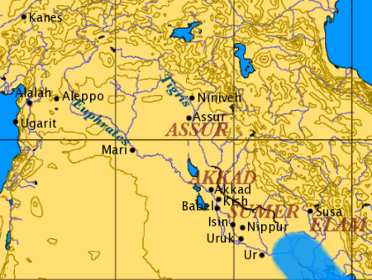Government in Mesopotamia from the Sumerian Civilization to the Persian Empire

Mesopotamia from the Sumerian Civilization to the Persian Empire experienced different forms of government which were greatly influenced by the geography of Mesopotamia, religion and culture of different civilizations that ruled the Fertile Crescent. Downfall of one civilization was followed by the rise of another but this did not necessarily resulted in the change of regime. The new rulers often took up the established system of government although they could also combine it with their own traditions or introduce something completely new.
Sumerian Priest-Kings
Southern Mesopotamia was occupied by the Sumerians as early as the 5th millennium BC. Their origin as well as prehistoric social organization remain a matter of debate, however, the archaeological finds imply that social stratification started very early. Scholars theorize that the Sumerians were perhaps initially organized into chiefdoms or primitive democracies. With the emergence of the Sumerian city-states in the late 4th millennium BC, Mesopotamia entered a new era. The first known states in history had a theocratic form of government. The city-states along the rivers Euphrates and Tigris were ruled by priest-kings called en, ensi or lugal who occasionally extended their authority over other city-states. Although they governed in the name of the gods to whom belonged all the land, their rule was not absolute. The Epic of Gilgamesh implies that the Sumerian priest-kings were assisted by one or more assemblies.
Introduction of Absolute Rule of a Great Individual by the Akkadians
The rule of priest-kings in Mesopotamia came to an end with the conquest of the region by Sargon of Akkad around 2340 BC. However, the Akkadian form of government was not any less theocratic. Even more, the Akkadian rulers from Sargon’s grandson Naram-Sin (ruled c. 2254-2218 BC) onward were not only regarded as vicars of the gods but as divine beings. Although the Akkadian rule in Mesopotamia was relatively short-lived, it established a new standard – an absolute rule of a great individual or autocracy which profoundly influenced the system of government in Mesopotamia until the fall of the Persian Empire in 330 BC.
Akkadian Influence on Neo-Sumerian and Babylonian Form of Government
The Sumerians briefly reestablished their hegemony in Mesopotamia under the Third Dynasty of Ur in the 21st and 20th centuries BC. Like their Akkadian predecessors, the rulers of the Third Dynasty of Ur had an absolute power and came to be regarded as divine from Shulgi (ruled c. 2094-2047 BC) onward. Strong central government also marked the Old Babylonian Empire which emerged as the dominant power in south-central Mesopotamia after the fall of the Third Dynasty of Ur about 1932 BC. The Kassites who gained control of Babylonia in the mid-2nd millennium BC established a network of principalities that were administrated by governors. About the same time the Hurrians founded the Mitanni Kingdom in northern Mesopotamia. Both the Kassite Babylonia and Mitanni Kingdom introduced a feudal form of government with warrior nobility as the ruling class.
Governmental Changes during the Assyrian Empire
The rise of the Assyrian Empire at the turn of the 1st millennium BC was marked by great territorial expansion. The power was centralized in the hands of the Assyrian kings who were also the high priests of Ashur, the chief god of Assyria. The Assyrian government was both theocratic and autocratic, while the vast empire was controlled by provincial governors who replaced the native rulers. The Assyrians are perhaps best known for mass deportation of rebellious populations which was also a common practice during the Neo-Babylonian Empire (626-529 BC) when took place the deportation of the Jews known as the Babylonian captivity.
Persian Government
Forced migrations came to an end after the rise of the Persian Empire (550-330 BC), also called the Achaemenid Empire which introduced a centralized government and efficient administration under the emperors who had an absolute authority. The vast empire was divided into provinces called the satrapies that were governed by the satraps. Each satrap was kept an eye on by a royal secretary and military commander responsible to the emperor alone. The Persian Empire was destroyed by Alexander the Great in 330 BC but its highly efficient centralized government greatly influenced the system of government of the later empires in both the Middle East and Europe.




